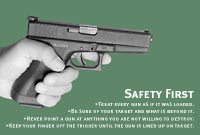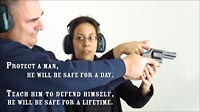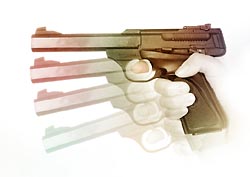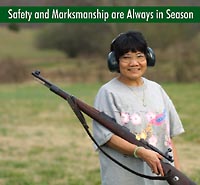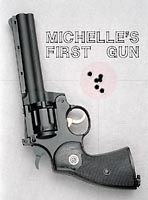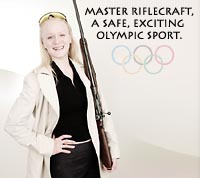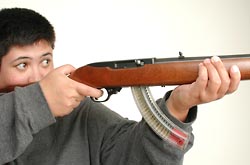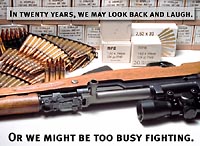|
|
Learning the basics of firearms is easy. Handling of guns is governed by four rules which, together, insure that no one would be hurt by accident. Be a responsible gun owner and lead your friends and family members to gun ownership by example. |
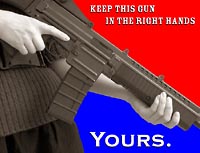 Hi-res |
It is a good idea to enlist a knowledgeable friend or a professional instructor in your effort. Most gun owners are happy to teach the basics of the craft to others. They can also inform you about the legal aspects of gun ownership in your area. In some states, buying a gun from an individual is unrestricted. In other states, you may need government permission to buy a firearm or an air gun. Once in possession of your first firearm, you can proudly say that you are doing your part to "keep guns out of the wrong hands." Tell any anti-gun objector that you are making sure that guns will be used only for good, one weapon at a time. |
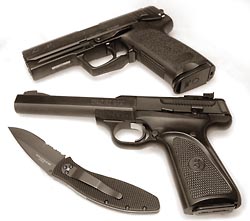 Hi-res |
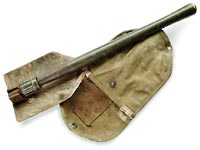 As with any other tools, begin by learning how to operate them safely. Guns are no different from other mechanical and power tools: if used as intended, they are safe to the users and to bystanders. No one sane would attribute magical powers to a shovel or a drill. Guns aren't any different. |
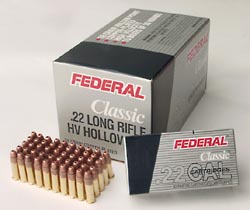 |
It is best to begin the learning process with a low-power gun. The most common, inexpensive caliber for the purpose is .22 (specifically, ".22 long rifle"). Ammunition of this type is cheap and produces minimal recoil and not too much muzzle flash or noise. For comparison, 500 rounds of .22 rimfire ammunition (suitable for use in handguns or rifles) cost about $10. The same ten dollars would buy only a 50-round box of centerfire pistol ammunition or a 20-round box of rifle ammunition. |
|
The main reason for using this caliber for learning is to avoid being intimidated by the weapon. Starting with a heavy-kicking, loud weapon is a sure way to building a flinch, and to not enjoying your range trip. Just compare the cartridges shown on the left: 20 gauge shotgun slug, 7.62mm Russian (AK47 round), 9mm Luger and the .22LR (5.6mm). So long as we are just punching holes in paper and learning to shoot accurately, there's no need to put up with the extra expense, noise and recoil. However, larger caliber guns are useful and fun to shoot once the basic skills have been honed. When choosing guns, consider comfort, reliability and ammunition availability. A light, powerful revolver would be of little use if you can't train with it due to the excessive recoil. An accurate, reliable rifle would hardly be practical if ammunition cost several dollars per round. |
|
|
Always wear eye protection when shooting. That protects your vision from accidents caused by ejected shell casings, fragments of unburned powder and other debris. Use hearing protection (ear plugs, ear muffs or both) when shooting. Unfortunately, the use of mufflers on firearms is restricted on the Federal level and outright prohibited in many states. The same states require mufflers on cars and motorcycles. No logic there. |
|
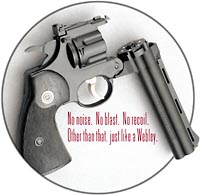 Hi-res |
You could begin by practicing with an pellet gun which uses compressed air, CO2 or a spring to propel a tiny pellet. They are similar to real firearms in the basics of safety and marksmanship. Practice with them is cheap, quiet and can be safely done at home, provided that all rules of gun handling are followed. This way people who are apprehensive about guns can learn the safety rules and enjoy shooting sports. Whether targeting a bullseye on paper or making a pop can move from a distance of several paces, shooting with air guns can be a great deal of fun. As with firearms, rules on pellet guns differ from state to state. Any adult can buy them in most locales, but in some government permission is required. |
|
|
|
|
The first firearms you buy need not be a pure training gun. Although .22 cartridge is marginally effective for self-defense, it is useful for hunting small game, competing in marksmanship contests and pure recreational fun. It need not be a handgun, either: a .22 bullet is faster and more effective when fired from a carbine. Carbines are also easier to shoot accurately than handguns because of the longer sight radius. |
|
| The best way to get started is to talk to your friends and see if they would be willing to teach you. You could also ask for advice on The High Road: it is full of helpful, knowledgeable people who could direct you to ranges and instructors in your area. | |
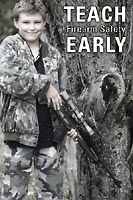 Hi-res |
Since kids may occasionally come into contact with firearms (and other power tools), teaching them the basics of safety is a good insurance against accidents and misuse. As with the basic sex education, knowledge of safe gun handling could easily be a life-saver. Moreover, if your kids show aptitude for shooting early on, they may wish to compete in sporting events or go huntings. Outdoor sports which include socializing with responsible adults certainly beat TV and video games as entertainment choices. |
|
Because of restrictive legislation, availability of legal firearms continues to decline. Access to ranges, availability of spare parts and ammunition are likewise being reduced. Because of these factors, it would be wise to acquire at least one defensive weapon now, just against the possibility of an un-anticipated ban. It is best to learn the basics of maintenance and keep a few spare parts in stock. |
|
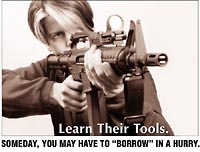 Hi-res |
In general, some proficiency with standard military and police weapons is handy. Almost all such small arms are based on about a dozen basic actions and use relatively common ammunition. Skills acquired with an AR15, for example, would transfer easily to an M16, CAR15, M4 or an AR10. Likewise, learning to use a semi-auto AK clone would be applicable to the entire AK family of assault rifles and machine guns, as well as Galil and Valmet rifles. |
| Why people own guns |
|
Fight, flight or surrender : Depending on others : Wearing arms : Homedefense : Real guns? : Martial Arts |
| Technology of firearms |
|
Long guns : Handguns : Becoming a gun owner : My Garand : Art of the Arms : Image library |
| Politics of self-defense |
| Gun control : Stay Safe : Effective guns : Necessary Evil : Media Bias : Get active |
| A fable : FAQ : Support this site : My forum : Newest posters |
